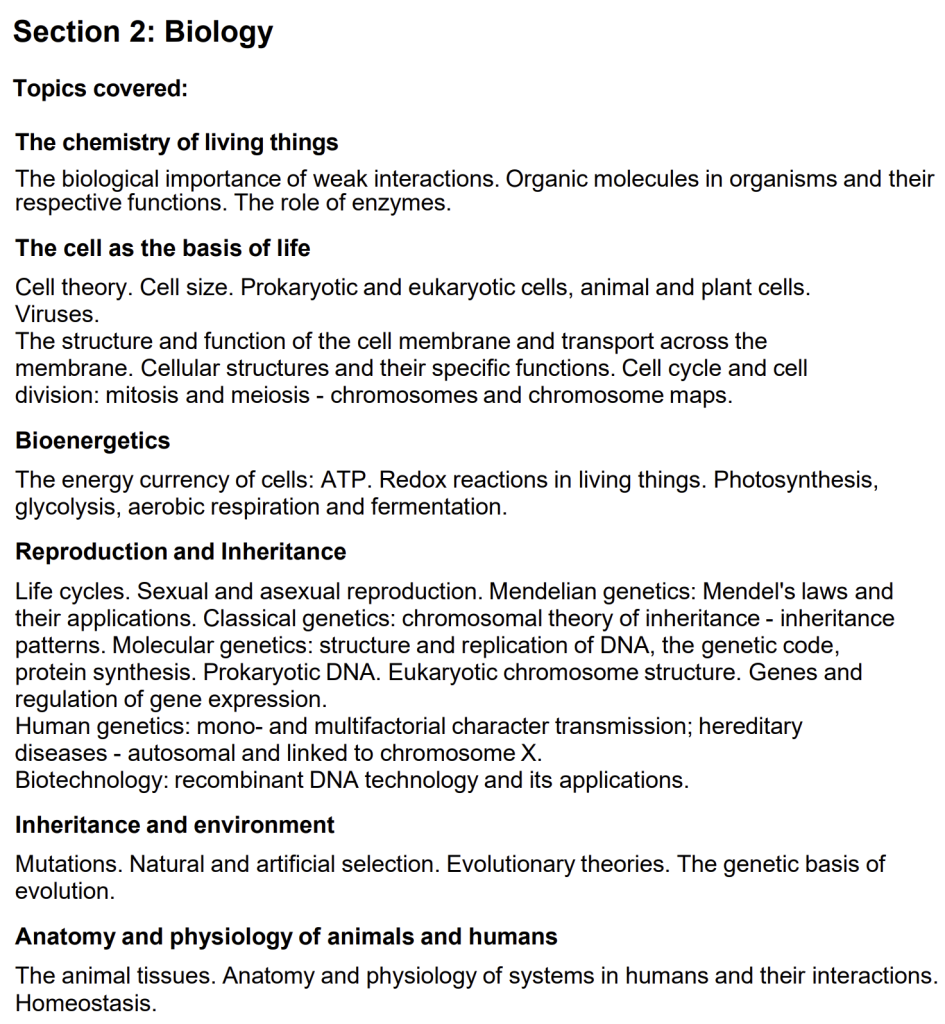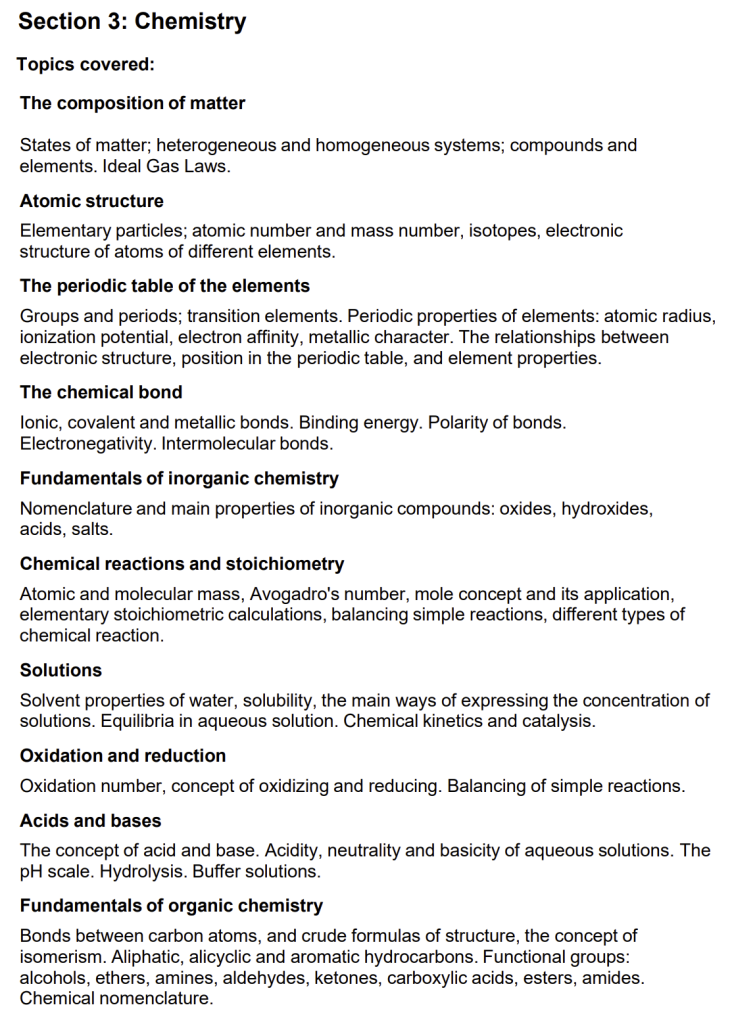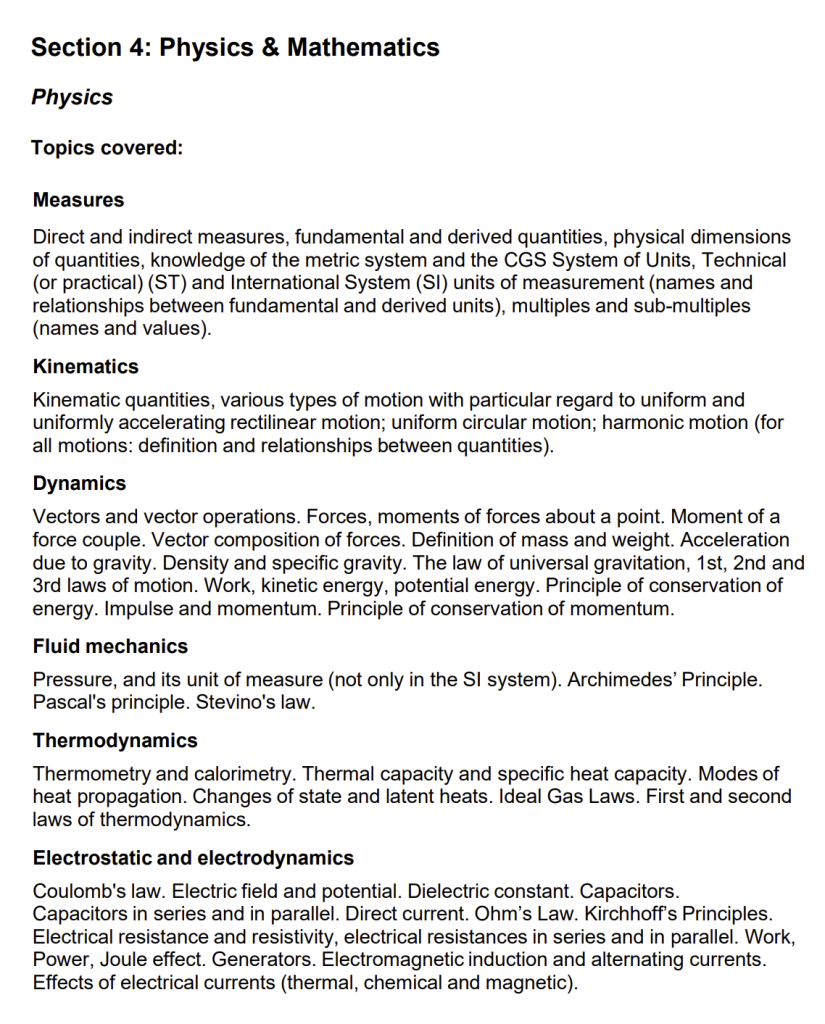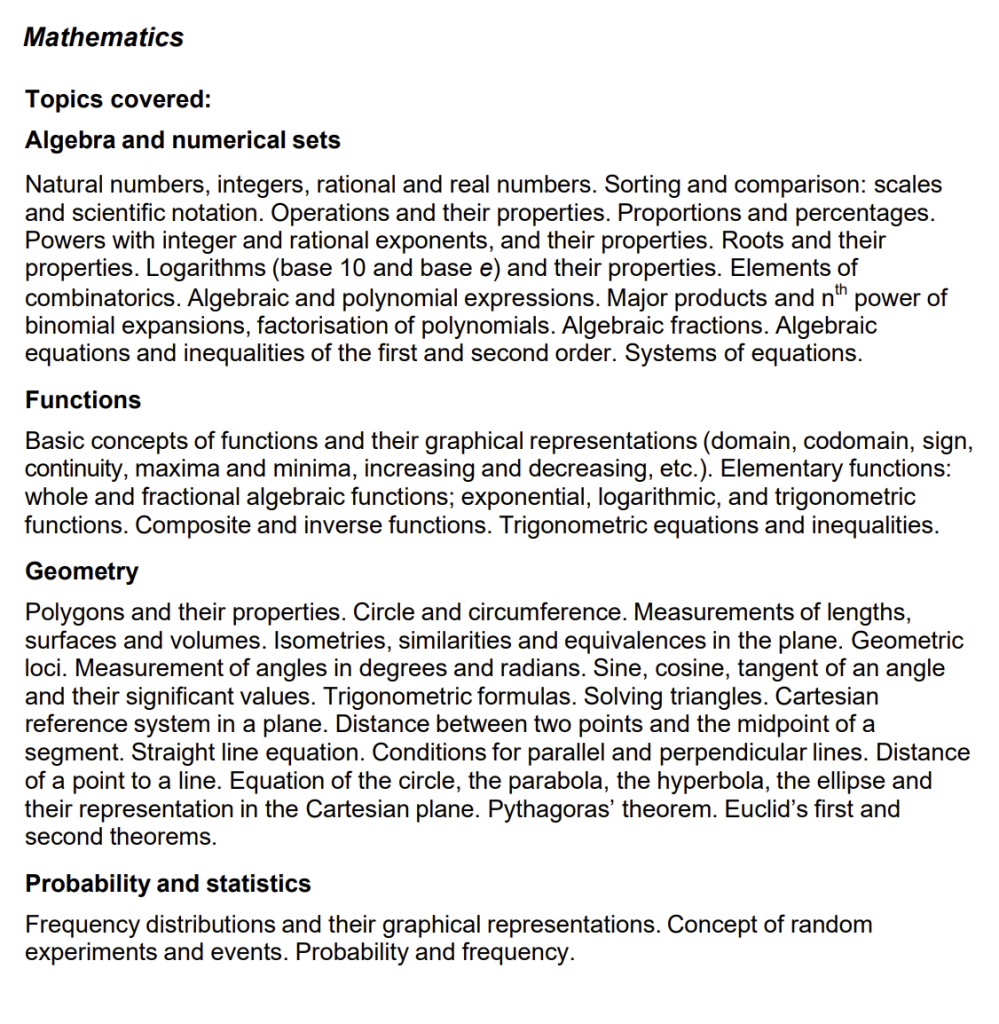

Ari Horesh University of Pavia, Italy
4th of March, 2023Welcome to our guide to IMAT 2023 syllabus and test specification! While the official IMAT syllabus and test specification for 2023 have not been announced yet, we can use the official materials from past years as a reliable guide for what to expect. This is especially true in Italy, where admission exams for medicine have been relatively consistent over the years, and in many other places in Europe.
Please note, today the 7th of August 2023, MUR announced the correct IMAT 2023 Test Specifications:


The IMAT exam is made up of multiple subjects, including Logic, General Knowledge, biology, chemistry, math, and physics. In recent years, there has been an increase in the number of math and physics questions on the exam. We believe that this trend will continue, as the medical field is beginning to implement new technological tools that require a greater understanding of these subjects. Therefore, it is essential for aspiring medical students to have a solid understanding of math and physics, as well as the other topics covered in the IMAT exam.
In this guide, we will break down and discuss all of the topics and subjects covered in the IMAT exam. We will provide you with the best books, chapters, and YouTube channels to study from for each one of these topics. With our guide, you will have everything you need to prepare for the IMAT exam and succeed on test day. So, let’s get started!



Psst.. we are here for you! Feel free to join our IMAT 2023 community by checking the menu above.
Content Quick Navigation
Section 1: Logic and General Knowledge
Section 1 of the IMAT exam assesses candidates’ general knowledge and thinking skills, which are essential for success in higher education. These skills are fundamental to academic studies, where students must often solve complex problems and evaluate arguments to arrive at a conclusion or defend a point of view. The questions in this section are designed to test candidates’ ability to analyze and understand a range of cultural topics, including literary, historical, philosophical, social, and political culture. Additionally, candidates must be able to think critically and solve problems, using logical reasoning and sound judgment to evaluate complex information. The ability to think critically and solve problems is vital to success not only in the medical field but also in many other fields of study. In the following sections, we will dive deeper into the specific topics and skills covered in Section 1 of the IMAT exam, including the General Knowledge section and the Critical Thinking and Problem Solving section, and provide tips and resources to help you succeed.
Critical Thinking and Problem Solving
The Critical Thinking and Problem Solving section of the IMAT is designed to test candidates’ ability to analyze and solve complex problems. This section may include questions that demand relevant selection, in which the task is to select only the necessary and helpful information for finding a solution. Often, real-world problems are overloaded with information, and being able to identify the key pieces of information is crucial.
In other questions, candidates may need to find procedures or methods for generating a solution. Even if all the relevant information has been selected, no solution may present itself, and it is up to the candidate to find a method or procedure to use.


Another type of question that may appear in this section is identifying similarity. Candidates will be presented with information and asked to identify the same information presented in a different way or a situation in which different information has a similar structure.
In addition to these question types, candidates may also encounter questions that involve summarizing the main conclusion, drawing a conclusion, identifying an assumption, assessing the impact of additional evidence, or detecting reasoning errors. These types of questions require critical thinking skills, as well as the ability to identify and evaluate arguments.
To perform well in the Critical Thinking and Problem Solving section of the IMAT, it is essential to develop a solid understanding of logical reasoning and problem-solving techniques. Practice identifying key pieces of information, finding methods or procedures for generating solutions, and identifying similarities between different sets of information. By honing these skills, you’ll be well-equipped to tackle the complex problems presented in this section of the exam.
| Question Type | Description |
| Summarizing the Main Conclusion | In this type of question, candidates must summarize the main conclusion of an argument. |
| Drawing a Conclusion | In this type of question, candidates must draw a conclusion based on the information provided. |
| Identifying an Assumption | In this type of question, candidates must identify the underlying assumption behind an argument. |
| Assessing the Impact of Additional Evidence | In this type of question, candidates must evaluate the impact of additional evidence on an argument. |
| Detecting Reasoning Errors | In this type of question, candidates must identify flaws in an argument’s reasoning. |
| Identifying Parallel Reasoning | In this type of question, candidates must identify similarities between two arguments. |
| Applying Principles | In this type of question, candidates must apply general principles to specific situations. |
To prepare for the Critical Thinking and Problem Solving section of the IMAT, the best way is to practice as many questions as possible. Using past papers of the BMAT section 1 and TSA can be a fantastic source of practice questions, as these exams also include sections on critical thinking and problem solving.
Additionally, there are many resources available for learning more about critical thinking and problem-solving techniques. One of the best books for this topic is “A Concise Introduction to Logic” by Patrick J. Hurley. This book covers everything you need to know about critical thinking, including arguments, deductive reasoning, fallacies, and more. By studying this book and practicing critical thinking questions, you’ll be well-equipped to tackle the Critical Thinking and Problem Solving section of the IMAT exam.
So, the Critical Thinking and Problem Solving section of the IMAT is designed to test candidates’ ability to analyze and solve complex problems. To succeed in this section, it is essential to develop a solid understanding of logical reasoning and problem-solving techniques. The best way to prepare is to practice as many questions as possible and use resources like past papers and “A Concise Introduction to Logic” to improve your critical thinking skills.
General Knowledge
The General Knowledge section of the IMAT may address a range of cultural topics, including aspects of literary, historical, philosophical, social, and political culture. These questions are not based on any specific part of school curricula. Instead, they aim to test candidates’ interest and knowledge in a wide variety of fields. For example, issues addressed during the studies or present in contemporary public discourse, 20th-century and current world history, and national indications and guidelines for “Citizenship and Constitution” (constitutional charter, communication, and the mass media, organization of the economy and political life, the different forms of state and government) may be covered.
It’s worth noting that in the past, it wasn’t recommended to study specifically for the General Knowledge section of the IMAT. This is because it can prove to be low yield and a waste of time, in contrast to studying high-yield biology or chemistry subjects that will almost certainly be asked on the exam. However, some topics that tend to repeat are authors, science figures, world organizations and their names, geography, and science Nobel Prize winners. Other than that, we don’t suggest trying to study specifically for this section. That said, it’s always fun to listen to podcasts or read articles about recent world events, as you never know when a question related to current events might pop up on the exam.
In summary, while General Knowledge is a part of the IMAT exam, it is not an area that requires intense studying or preparation. Rather, candidates with a broad range of knowledge and a keen interest in current events will likely perform well on this section. The best strategy for success is to focus on studying the high-yield subjects like biology and chemistry, while also keeping up with current events in your free time.
Section 2: Biology


The chemistry of living things
The biological importance of weak interactions, organic molecules in living organisms and their respective functions, and the role of enzymes are important concepts to understand for the IMAT exam. To study these concepts, we recommend checking out YouTube channels such as Bozeman Science, Crash Course Biology, and Amoeba Sisters, which provide informative videos on different aspects of biology and chemistry.
The cell as the basis of life
Cell theory, cell size, prokaryotic and eukaryotic cells, animal and plant cells, viruses, the structure and function of the cell membrane and transport across the membrane, and cellular structures and their specific functions are all important topics covered in the cell section of the IMAT exam. For this section, we recommend checking out resources such as Khan Academy and the Biology Corner, which provide detailed explanations and diagrams of these topics.
Bioenergetics
The energy currency of cells, ATP, redox reactions in living things, and different types of cellular respiration (photosynthesis, glycolysis, aerobic respiration, and fermentation) are all important concepts to understand for the bioenergetics section of the IMAT exam. For this section, we recommend checking out YouTube channels such as Bozeman Science, Crash Course Biology, and Amoeba Sisters, which provide informative videos on these topics.
Reproduction and Inheritance
The reproduction and inheritance section of the IMAT exam covers a wide range of topics, including life cycles, sexual and asexual reproduction, Mendelian genetics, chromosomal theory of inheritance, molecular genetics, prokaryotic DNA, eukaryotic chromosome structure, genes and regulation of gene expression, human genetics, and biotechnology. For this section, we recommend checking out resources such as Khan Academy, Crash Course Biology, and Bozeman Science, which provide detailed explanations and videos on these topics.
Inheritance and environment
The inheritance and environment section of the IMAT exam covers mutations, natural and artificial selection, evolutionary theories, the genetic basis of evolution, and the anatomy and physiology of animals and humans. For this section, we recommend checking out resources such as Khan Academy and Crash Course Biology, which provide detailed explanations and videos on these topics.
Anatomy and Physiology of animals and humans
The anatomy and physiology section of the IMAT exam covers animal tissues, anatomy of the major organs and their functions and interactions in humans, and homeostasis. For this section, we recommend checking out resources such as Khan Academy and AnatomyZone, which provide detailed diagrams and videos on these topics.
Section 3: Chemistry


The composition of matter
The IMAT exam’s chemistry section begins with the composition of matter, which covers states of matter, compounds and elements, and ideal gas laws. To study this section, we recommend checking out resources such as Khan Academy and Crash Course Chemistry on YouTube, which provide detailed explanations and videos on these topics.
Atomic structure
Elementary particles, atomic number and mass number, isotopes, and electronic structure of atoms of different elements are important topics in the atomic structure section of the IMAT exam. To study this section, we recommend checking out resources such as Khan Academy and Bozeman Science, which provide detailed explanations and diagrams of these topics.
The periodic table of the elements
The periodic table is an essential tool for understanding chemistry, and the IMAT exam covers groups and periods, transition elements, and periodic properties of elements. For this section, we recommend checking out resources such as Crash Course Chemistry and Periodic Videos on YouTube, which provide informative videos on these topics.
The chemical bond
The IMAT exam’s chemistry section covers ionic, covalent, and metallic bonds, the polarity of bonds, electronegativity, and intermolecular bonds. To study this section, we recommend checking out resources such as Khan Academy and Crash Course Chemistry on YouTube, which provide detailed explanations and videos on these topics.
Fundamentals of inorganic chemistry
The fundamentals of inorganic chemistry section of the IMAT exam covers nomenclature and main properties of inorganic compounds, including oxides, hydroxides, acids, and salts. To study this section, we recommend checking out resources such as Khan Academy and Crash Course Chemistry on YouTube, which provide detailed explanations and videos on these topics.
Chemical reactions and stoichiometry
The chemical reactions and stoichiometry section of the IMAT exam covers atomic and molecular mass, Avogadro’s number, mole concept and its application, elementary stoichiometric calculations, and balancing simple reactions. For this section, we recommend checking out resources such as Khan Academy and Crash Course Chemistry on YouTube, which provide detailed explanations and videos on these topics.
Solutions
The solutions section of the IMAT exam covers solvent properties of water, solubility, the main ways of expressing the concentration of solutions, equilibria in an aqueous solution, and chemical kinetics and catalysis. To study this section, we recommend checking out resources such as Khan Academy and Crash Course Chemistry on YouTube, which provide detailed explanations and videos on these topics.
Oxidation and reduction
The oxidation and reduction section of the IMAT exam covers oxidation number, the concept of oxidizing and reducing, and balancing of simple reactions. For this section, we recommend checking out resources such as Khan Academy and Crash Course Chemistry on YouTube, which provide detailed explanations and videos on these topics.
Acids and bases
The IMAT exam’s chemistry section covers the concept of acid and base, acidity, neutrality, and basicity of aqueous solutions, the pH scale, hydrolysis, and buffer solutions. To study this section, we recommend checking out resources such as Khan Academy and Crash Course Chemistry on YouTube, which provide detailed explanations and videos on these topics.
Fundamentals of organic chemistry
The IMAT exam’s chemistry section concludes with the fundamentals of organic chemistry, covering bonds between carbon atoms, crude formulas of structure, the concept of isomerism, and different functional groups. For this section, we recommend checking out resources such as Khan Academy and Crash Course Chemistry on YouTube, which provide detailed explanations and videos on these topics.
By utilizing these resources, you can gain a deeper understanding of the concepts covered in the IMAT chemistry section and prepare more effectively for the exam
Section 4: Math and Physics




The IMAT physics and mathematics section is designed to test the mathematical and scientific knowledge of candidates aspiring to pursue a career in the field of medicine. It is essential to have a good understanding of the fundamental concepts of mathematics and physics, as well as their applications in the medical field. Here is a breakdown of the IMAT physics and mathematics syllabus with some recommended resources to help you prepare for the exam.
Measures
This section covers the fundamental units and dimensions of quantities. Candidates are expected to have a good knowledge of the metric system and the SI system of units, multiples and sub-multiples, and the relationships between fundamental and derived units. Khan Academy is a great resource for learning about measures.
Kinematics and Dynamics
This section deals with the various types of motion, including uniform and uniformly accelerating rectilinear motion, uniform circular motion, and harmonic motion. It also covers vectors and vector operations, forces, moments of forces, mass, weight, and acceleration due to gravity. Candidates should be familiar with the laws of motion, work, kinetic energy, potential energy, impulse, and momentum. The best resources to learn about kinematics and dynamics are Physics Classroom and Crash Course Physics on YouTube.
Fluid Mechanics and Thermodynamics
This section covers the principles of fluid mechanics, including pressure, Archimedes’ Principle, and Pascal’s principle. It also covers thermometry and calorimetry, changes of state and latent heat, and the first and second laws of thermodynamics. Candidates should have a good understanding of the ideal gas laws. Crash Course Physics and Khan Academy are great resources for learning about fluid mechanics and thermodynamics.
Electrostatic and Electrodynamics
This section covers Coulomb’s law, electric field and potential, dielectric constant, capacitors, capacitors in series and in parallel, direct current, Ohm’s Law, Kirchhoff’s Principles, and electrical resistance and resistivity. Candidates should also be familiar with generators, electromagnetic induction, and alternating currents. Khan Academy and Physics Classroom are great resources for learning about electrostatics and electrodynamics.
Algebra and Numerical Sets
This section covers algebraic expressions and equations, polynomials, and systems of equations. Candidates should also have a good understanding of numerical sets, natural numbers, integers, rational and real numbers, proportions and percentages, powers, roots, and logarithms. Khan Academy and Math Antics are great resources for learning about algebra and numerical sets.
Functions and Geometry
This section deals with the basic concepts of functions and their graphical representations. Candidates should be familiar with the elementary functions, composite and inverse functions, and trigonometric equations and inequalities. Geometry covers polygons and their properties, circle and circumference, Cartesian reference system, equations of straight lines and circles, and the distance between two points. Khan Academy and Math Antics are great resources for learning about functions and geometry.
Probability and Statistics
This section covers frequency distributions and their graphical representations, probability, and frequency. Candidates should have a good understanding of random experiments and events. Crash Course Statistics and Khan Academy are great resources for learning about probability and statistics.
In conclusion, the IMAT physics and mathematics section requires candidates to have a good understanding of the fundamental concepts of mathematics and physics. Using online resources such as Khan Academy, Physics Classroom, Crash Course Physics, Math Antics, and Crash Course Statistics, can help candidates prepare for the exam and perform well on the day.


